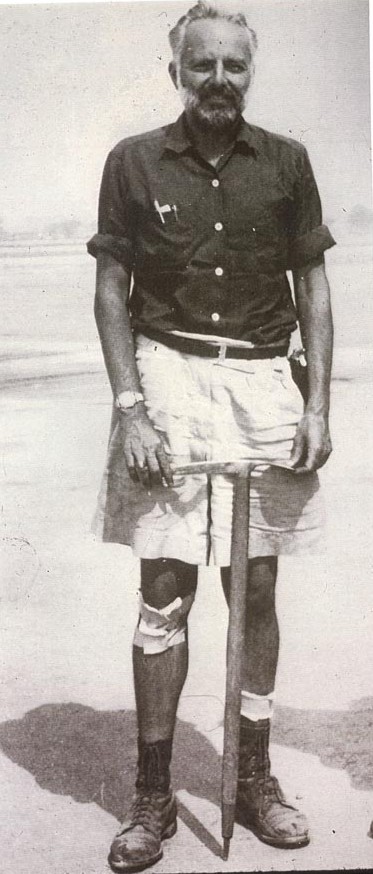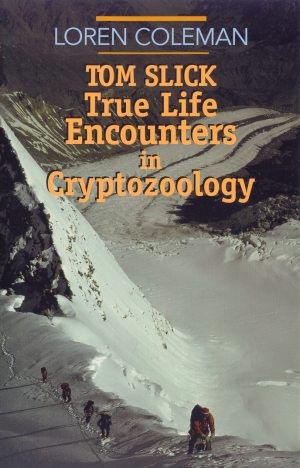
April 8, 2006
In conjunction with the University of Texas’ display, "Bigfoot in Texas?" this weekend, one of the speakers will be Catherine Nixon Cooke, a niece of Tom Slick. Ms. Cooke in 2005 published her book, Tom Slick, Mystery Hunter from Paraview, Inc.
A question I would ask her if I was there: Was the late Texas oil and beef millionaire Tom Slick partially using his Snowmen expeditions to hide, in plain sight, his spying activity?
Tom Slick’s life-long cryptozoological pursuits have been worthy of my attention for 46 years. My awareness about his probable spying has occurred in the last two decades.
Cooke only vaguely deals with Tom Slick’s possible involvement with 1950s’ spooks, spies, and intelligence services in her book, when she writes one long sentence on the topic, on page 67: "There have always been rumors in the family that he was involved in special intelligence projects; but no real evidence has been found; and the CIA has no record of any work Slick may have done for its predecessor, the OSS (Office of Strategic Services)."
The question of Slick’s spying saw my name appear in a review of Cooke’s book, written by Ed Conroy of the San Antonio Express-News of December 4, 2005. Conroy wrote:
Some popular writers, such as cryptozoologist Loren Coleman, have explored rumors Tom Slick may have been an agent for the CIA, adopting the cover of "Yeti hunter" while spying on communist Chinese troop movements. Cooke’s response to that suggestion is characteristically matter-of-fact. "I found no reference whatsoever to any involvement with the CIA in any of his letters," she said.
I asked my friend, university archivist, editor of Steamshovel Press, and a writer of some note on intelligence work, Kenn Thomas about Cooke’s response. His reply was simple and to the point: "The absence of an obvious public confession is not evidence of the absence of any covert intelligence activity on the part of Tom Slick’s."
My book, Tom Slick: True Life Encounters in Cryptozoology has an entire appendix, "Tom Slick and the CIA: An Open Question," pages 178-203, about Slick’s intriguing travels, his probable involvement with the shadowy world of the OSS and the CIA, and how even Slick Airways became, more so after his death, an air carrier for Air Asia, which was a part itself of Air America, what are technically called subsidiaries of CIA proprietaries, in spy-talk.

The paper trail is long, in this regard, going all the way to the Supreme Court, where a ruling upheld a refusal to unseal papers involving the major intelligence services actors here. But it started long ago. Even The New York Times saw fit to publish an article reporting on the Russians’ promotion of the Yeti-as-cover-story in an item entitled: "Soviet Sees Espionage in U. S. Snowman Hunt." The April 27,1957 piece claimed Slick was behind an effort to subvert the Chinese, and free Tibet.
The fact of the matter, Cooke’s book has no footnotes, references, sources, and such, unlike mine, which took years of research, FOIA searches, and an academic approach to looking at Tom Slick’s life in cryptozoology and intelligence. Cooke’s is a good book for getting a feeling of the man, and it does that well, but don’t look to find out more about the mystery of Yetis and Bigfoot there. Or about spies in it either.
Cooke’s first chapter of ten is about her 2001 trip to the Himalayas, backtracking her uncle’s trek in search of Yeti, and really, as she admits, about her personal quest for the "ghost" of her uncle. Chapter seven is about Slick’s time in Nepal, reconstructed mostly from letters. The book is, in essence, about Tom Slick family life, as viewed through a family members’ eyes, and not about cryptozoology, of course. It is worthwhile on that level.

Tom Slick’s involvement with Bigfoot research is limited to mentions on the parts of two pages where Cooke talks about the quests as "family adventures."
"Cryptozoologist Dr. Richard Greenwell has statistically analyzed some of the data at the University of Arizona and remains convinced of the expedition’s credibility," notes Cooke at the bottom of page 150. Without going too deeply into the issue that Greenwell’s "Dr." was an honorary degree from a Mexican university, unfortunately, with Greenwell’s death two months after the book’s appearance, we can’t interview him for insights into what his analyses involved.
On the next page, Cooke writes: "According to Greenwell, [John] Green reported capturing clear ‘Bigfoot tracks’ on slide film. He gave the undeveloped rolls to [Bob] Titmus, who sent them on to Slick in Texas. More than forty years later, they have never been seen; they remain, like the yeti thumb, part of a lingering mystery. Author Loren Coleman explored that mystery in 1989, when he published Tom Slick and the Search for the Yeti and the annual Bigfoot Conference (in different locations each year) remains a forum for the latest theories and expedition news about the elusive creature."
Cooke appears unaware that there is not a monothematic Bigfoot conference run by one group that pops up in various parts of North America every year, but instead a diverse and individual regional collection of selected groups that often have annual conferences in widely-separate locations, for example, in Texas, Ohio, and the Pacific Northwest.
Furthermore, Cooke’s information is incorrect about Slick’s missing evidence. Selections of the thumb were re-discovered by the late George Agogino and re-tested in 1991, with the results found to be "near human" and "inconclusive." Cooke, as noted above, of course, seems unacquainted with the fact my 1989 book was revised and reprinted in 2002, by Linden Press as Tom Slick: True Life Encounters in Cryptozoology.

About Loren Coleman
Loren Coleman is one of the world’s leading cryptozoologists, some say “the” leading living cryptozoologist. Certainly, he is acknowledged as the current living American researcher and writer who has most popularized cryptozoology in the late 20th and early 21st centuries.
Starting his fieldwork and investigations in 1960, after traveling and trekking extensively in pursuit of cryptozoological mysteries, Coleman began writing to share his experiences in 1969. An honorary member of Ivan T. Sanderson’s Society for the Investigation of the Unexplained in the 1970s, Coleman has been bestowed with similar honorary memberships of the North Idaho College Cryptozoology Club in 1983, and in subsequent years, that of the British Columbia Scientific Cryptozoology Club, CryptoSafari International, and other international organizations. He was also a Life Member and Benefactor of the International Society of Cryptozoology (now-defunct).
Loren Coleman’s daily blog, as a member of the Cryptomundo Team, served as an ongoing avenue of communication for the ever-growing body of cryptozoo news from 2005 through 2013. He returned as an infrequent contributor beginning Halloween week of 2015.
Coleman is the founder in 2003, and current director of the International Cryptozoology Museum in Portland, Maine.
Filed under Abominable Snowman, Breaking News, CryptoZoo News, Cryptozoology, Museums, Obituaries, Pop Culture, Sasquatch, Yeti